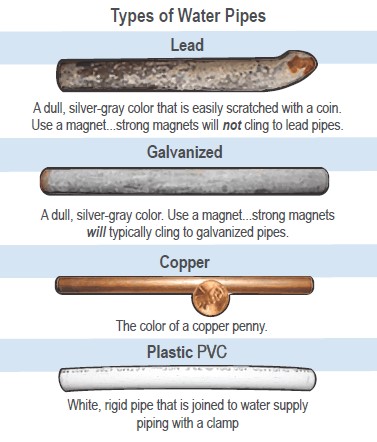Page last updated on March 20, 2025 at 8:56 am
Lead & Copper
Although lead and copper occur naturally in the environment, those metals enter drinking water primarily through plumbing materials. Exposure to lead and copper may cause health problems ranging from stomach distress to brain damage. In 1991, the Environmental Protection Agency (EPA) published a regulation to control lead and copper in drinking water. This regulation is known as the Lead and Copper Rule (also referred to as the LCR). The treatment technique for the rule requires systems to monitor drinking water at customer taps. If lead concentrations exceed an action level of 15 parts per billion (ppb) or copper concentrations exceed an action level of 1.3 parts per million (ppm) in more than 10% of customer taps sampled, the system must undertake a number of additional actions to control corrosion. If the action level for lead is exceeded, the system must also inform the public about steps they should take to protect their health and may have to replace lead service lines under their control. EPA’s 2023 Lead and Copper Rule Improvements better protects children and communities from the risks of lead exposure by reducing the action level of lead, ensuring lead service line replacement, better protecting children at schools and childcare facilities, getting the lead out of our nation’s drinking water, and empowering communities through information. More information about CBU's service line inventory program.
The water provided to homes and businesses by the City of Bloomington Utilities (CBU) is lead-free, but lead can get into the water through water service lines, household plumbing, and fixtures that supply water to our consumers.
Through this program, CBU is:
- Replacing all lead and galvanized requiring replacement (GRR) service lines within the next 10 years
- Providing water pitchers, filters, and replacement filters to consumers with lead and GRR service lines until 6 months post replacement.
- Adjusting the potential of hydrogen (pH) of the water to reduce the risk of lead getting into the drinking water from lead service lines.
- Testing schools, daycares, and childcare facilities built before 2017 for lead in the drinking water
- Offering in-home lead testing from any consumer with a lead, GRR, or unknown service line at the request of the consumer.
What you need to know:
- The City of Bloomington is working on securing funding from the state and federal government to help offset the costs of these extensive programs
- In the coming months, CBU will compile a replacement plan to meet EPA and Indiana Department of Environmental Management (IDEM) regulations for service line replacements as part of the lead and copper rule improvements.
- CBU will continue to identify and verify service lines to help fill in more of the service line inventory

